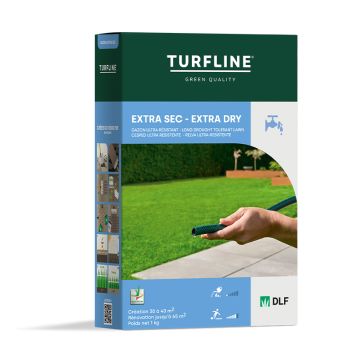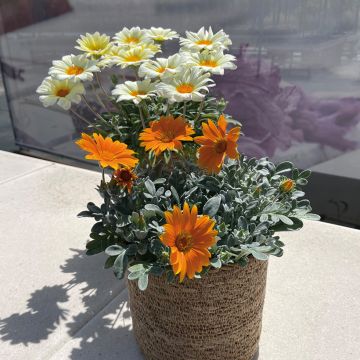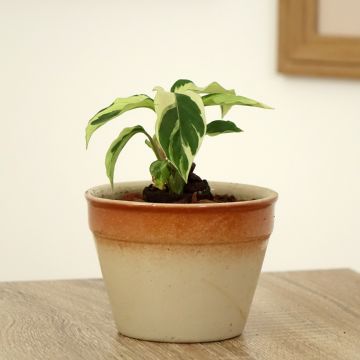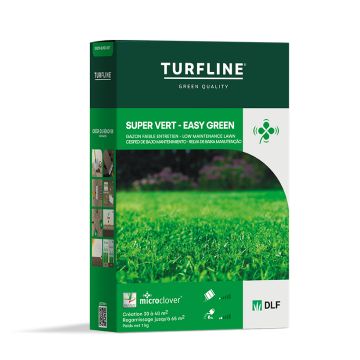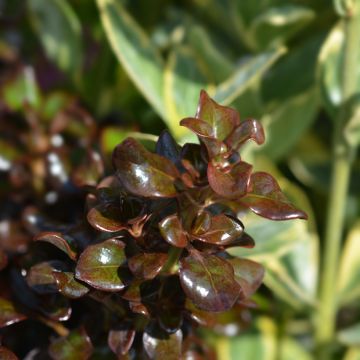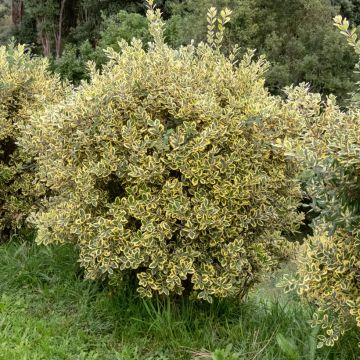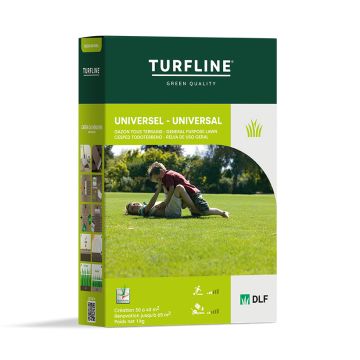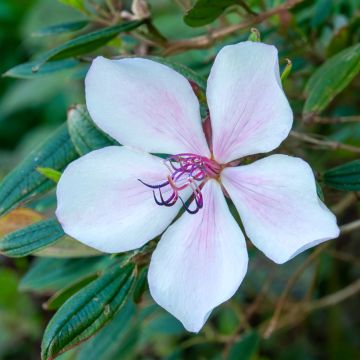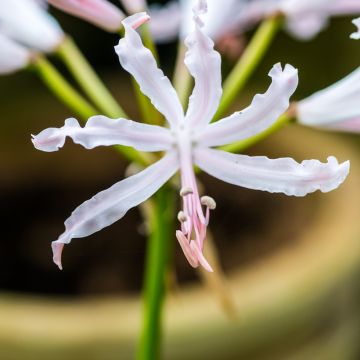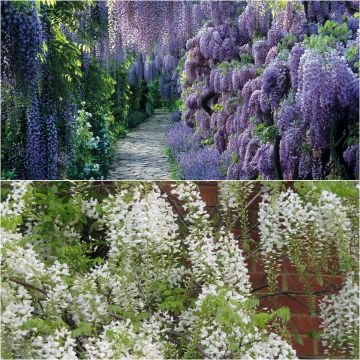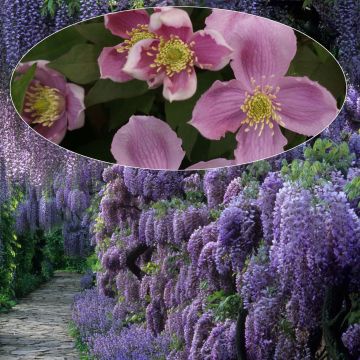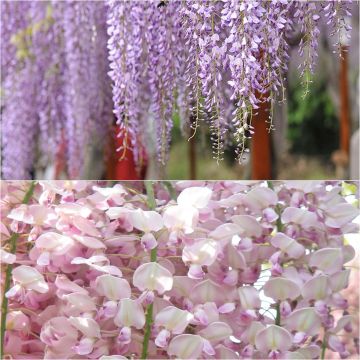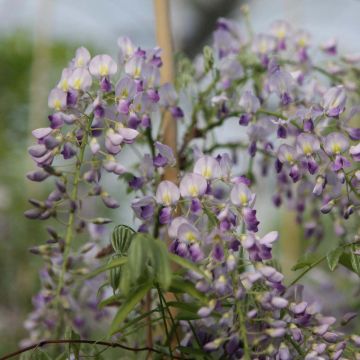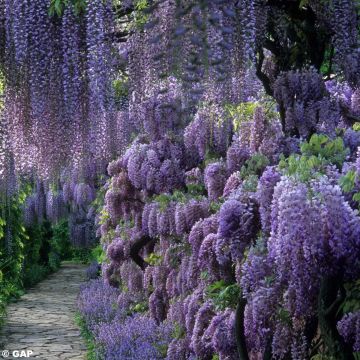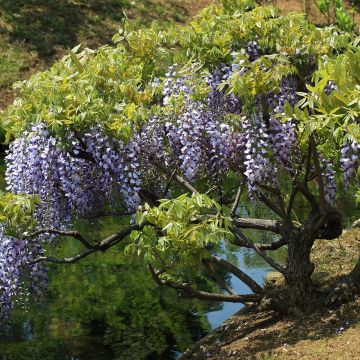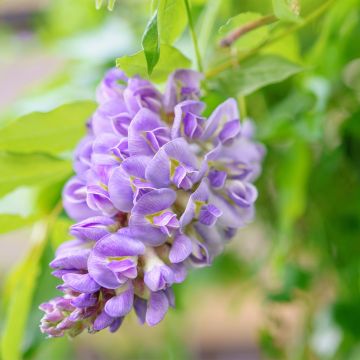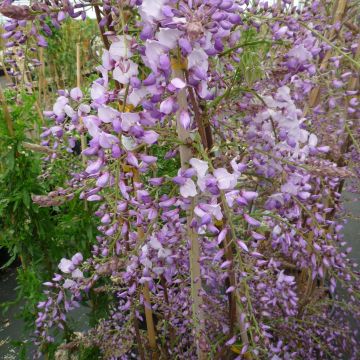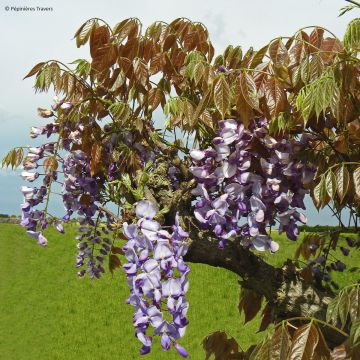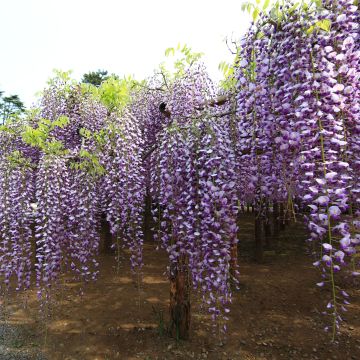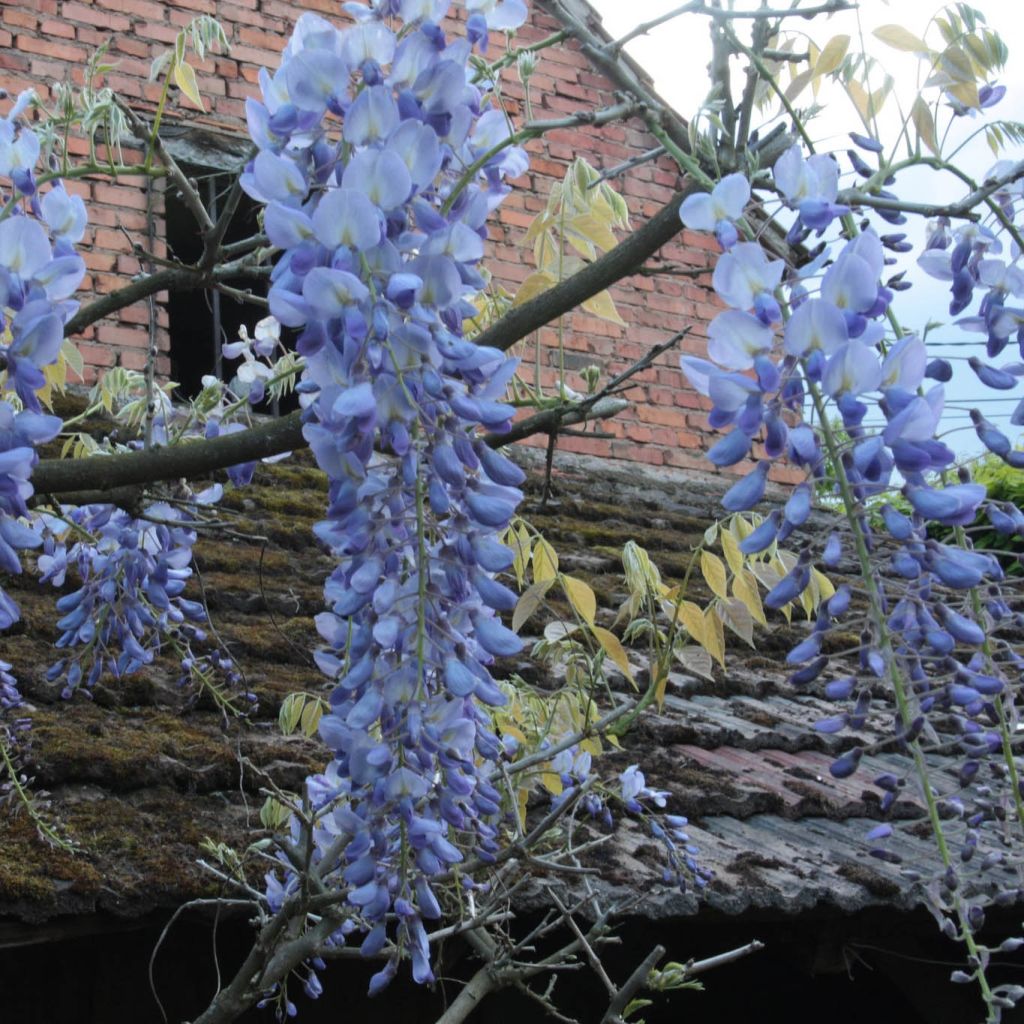

Wisteria frutescens var. macrostachya Blue Moon
Wisteria frutescens var. macrostachya Blue Moon
Wisteria frutescens var. macrostachya Blue Moon
American Wisteria
Why not try an alternative variety in stock?
View all →This plant carries a 6 months recovery warranty
More information
We guarantee the quality of our plants for a full growing cycle, and will replace at our expense any plant that fails to recover under normal climatic and planting conditions.
From €7.90 for pickup delivery and €6.90 for home delivery
Express home delivery from €8.90.
Does this plant fit my garden?
Set up your Plantfit profile →
Description
Wisteria 'Blue Moon' is a beautiful descendant of a wild American wisteria that is extremely cold-resistant. This variety charms with its long clusters of lavender-blue flowers that are dense and fragrant. They appear in abundance in late spring, along with its young leaves. The flowers bloom again, more sporadically, nestled in its beautiful dark green leaves. It flowers once or twice more during summer. Wisterias spontaneously and voluptuously wrap their long, twining stems around railings, fences, neighbouring plants, pergolas, and arbours, transforming them into flowering structures. 'Blue Moon' sometimes takes time to establish and bloom, but it is a beautiful garden plant that will make an even greater impact if trained as a tree.
The American wisteria is a woody, deciduous climbing plant belonging to the large Fabaceae family, just like clover, alfalfa, or lupins. Its subspecies macrostachya is native to humid forests and riverbanks in a geographic area ranging from southern Missouri and Illinois to eastern Kentucky. It has the peculiarity of producing its flower buds on the current year's wood rather than in summer, which protects the flowering from heavy frosts. Its long twining stems, slightly less vigorous than those of Chinese wisteria, lignify with age. It is a perfectly cold-resistant plant. It is undemanding in terms of soil (although it does not tolerate active limestone), and can grow in periodically waterlogged or, conversely, poor and fairly dry soils in summer if they are deep.
The compact and highly floriferous 'Blue Moon' was selected in Minnesota, USA for its resistance to long and harsh winters. Its stems easily reach 4m (13ft) in length and twine around supports spontaneously, in a counterclockwise direction. The growth of new shoots is rapid, with about 80cm (32in) in a single season if planted in moist soil. The main flowering of this variety takes place in May-June, on plants that are at least 3-4 years old. It develops on leafy branches located near the main lignified stems. It bears long clusters of small blue-mauve flowers speckled with yellow-green, measuring 20 to 35cm (8 to 14in). The tightly packed blooms emit a pleasant fragrance in calm weather. They open from the base towards the tip of the cluster. The plant reblooms during summer. Its flowering is nectar-rich and attractive to bees. The young bronze leaves appear at the end of flowering and then turn dark green, before turning yellow in autumn and falling off. They are 10 to 30cm (4 to 12in) long and divided into 9 to 15 rounded leaflets, giving the foliage a light appearance. The brown fruit is a flattened pod, 5 to 10cm (2 to 4in) long, which persists until winter. It contains numerous small brown kidney-shaped seeds. The 'Blue Moon' wisteria can live well over 50 years.
'Blue Moon' is slightly less vigorous than its Asian counterparts, but is better suited for small gardens. It can enhance any facade or structure, no matter how modest. It is also particularly useful for covering a wall or an unsightly fence. It wraps itself around a fence or trellis without restraint if left to its own devices. It tends to smother surrounding plants. Plant it on its own in full sun (or partial shade in hot climates). Alternatively, plant it with equally powerful honeysuckles, such as the evergreen Lonicera x delavayi, with a fragrant yellow summer flowering, or the thornless Banksia rose 'Alba Plena', which is covered in small white pompoms in May. It also gets along very well with Clematis montana. With careful pruning, this variety can become a magnificent small tree, to be placed prominently in the garden.
However, be patient! Its first flowering only appears after 2 to 3 years, depending on growing conditions.
Wisteria frutescens var. macrostachya Blue Moon in pictures
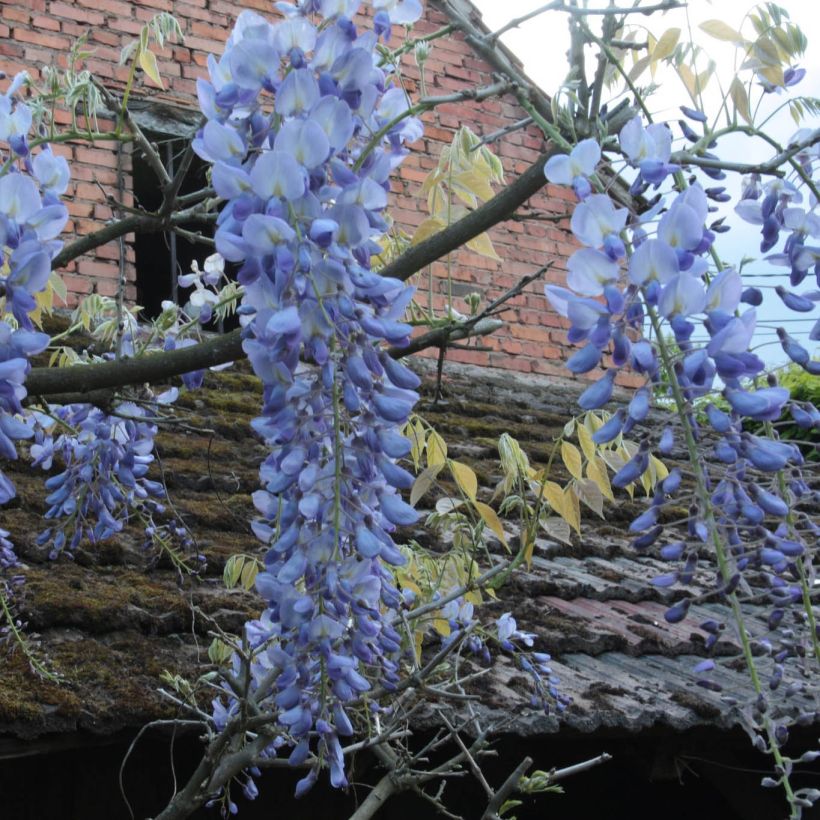

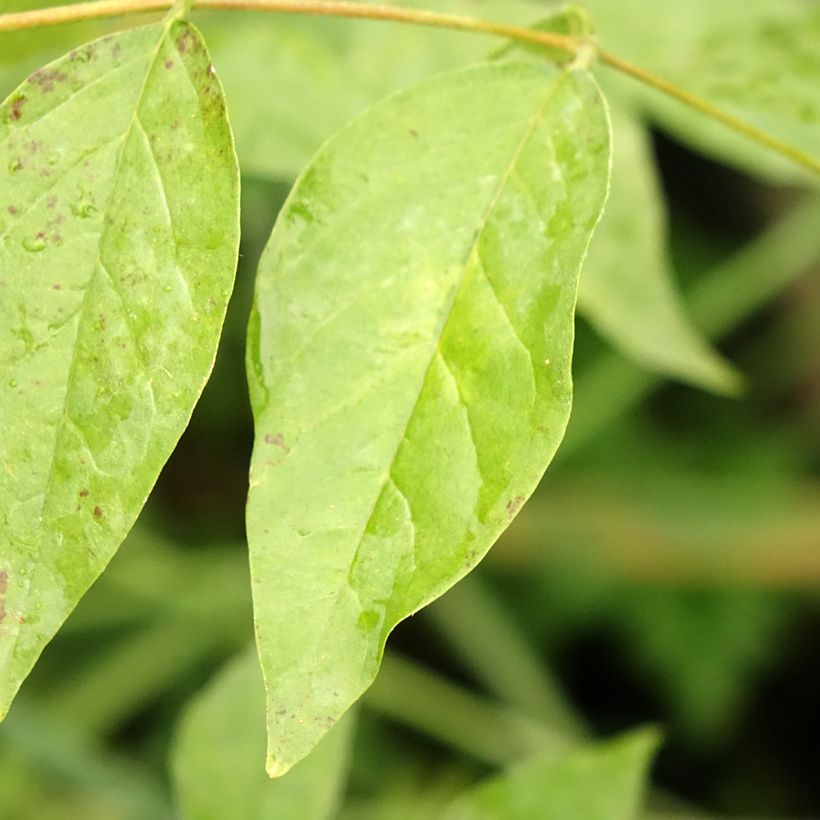

Plant habit
Flowering
Foliage
Botanical data
Wisteria
frutescens var. macrostachya
Blue Moon
Fabaceae
American Wisteria
Cultivar or hybrid
Other Wisterias
View all →Planting and care
American wisteria is an easy-to-grow plant if the soil is sufficiently deep and moist. It can grow in any garden soil, with a preference for poor and slightly acidic soils. It may wither in overly calcareous soil (pH>7.5). Once established, it can withstand summer drought fairly well and does not require watering in most of our regions, except perhaps in warmer climates. Conversely, it can tolerate soils that are occasionally waterlogged. Plant it along a wall or train it on a pergola. Pruning is recommended to achieve better flowering, and even multiple flowerings in the season.
Wisterias can be trained as trees by growing them on a "parasol" stake measuring 1.5 to 2m (5 to 7ft), or used as ground cover in a large wild garden.
Planting period
Intended location
Care
This item has not been reviewed yet - be the first to leave a review about it.
Haven't found what you were looking for?
Hardiness is the lowest winter temperature a plant can endure without suffering serious damage or even dying. However, hardiness is affected by location (a sheltered area, such as a patio), protection (winter cover) and soil type (hardiness is improved by well-drained soil).

Photo Sharing Terms & Conditions
In order to encourage gardeners to interact and share their experiences, Promesse de fleurs offers various media enabling content to be uploaded onto its Site - in particular via the ‘Photo sharing’ module.
The User agrees to refrain from:
- Posting any content that is illegal, prejudicial, insulting, racist, inciteful to hatred, revisionist, contrary to public decency, that infringes on privacy or on the privacy rights of third parties, in particular the publicity rights of persons and goods, intellectual property rights, or the right to privacy.
- Submitting content on behalf of a third party;
- Impersonate the identity of a third party and/or publish any personal information about a third party;
In general, the User undertakes to refrain from any unethical behaviour.
All Content (in particular text, comments, files, images, photos, videos, creative works, etc.), which may be subject to property or intellectual property rights, image or other private rights, shall remain the property of the User, subject to the limited rights granted by the terms of the licence granted by Promesse de fleurs as stated below. Users are at liberty to publish or not to publish such Content on the Site, notably via the ‘Photo Sharing’ facility, and accept that this Content shall be made public and freely accessible, notably on the Internet.
Users further acknowledge, undertake to have ,and guarantee that they hold all necessary rights and permissions to publish such material on the Site, in particular with regard to the legislation in force pertaining to any privacy, property, intellectual property, image, or contractual rights, or rights of any other nature. By publishing such Content on the Site, Users acknowledge accepting full liability as publishers of the Content within the meaning of the law, and grant Promesse de fleurs, free of charge, an inclusive, worldwide licence for the said Content for the entire duration of its publication, including all reproduction, representation, up/downloading, displaying, performing, transmission, and storage rights.
Users also grant permission for their name to be linked to the Content and accept that this link may not always be made available.
By engaging in posting material, Users consent to their Content becoming automatically accessible on the Internet, in particular on other sites and/or blogs and/or web pages of the Promesse de fleurs site, including in particular social pages and the Promesse de fleurs catalogue.
Users may secure the removal of entrusted content free of charge by issuing a simple request via our contact form.

































